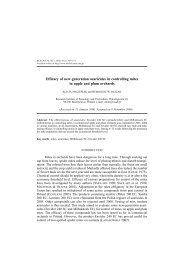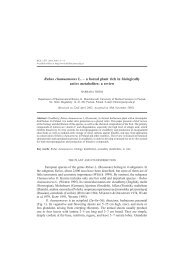The possible hybrid origin of the feather mite Avenzoaria canuti ...
The possible hybrid origin of the feather mite Avenzoaria canuti ...
The possible hybrid origin of the feather mite Avenzoaria canuti ...
Create successful ePaper yourself
Turn your PDF publications into a flip-book with our unique Google optimized e-Paper software.
124 Agnieszka Badek and Jacek Dabert<br />
Fig. 5. Results <strong>of</strong> <strong>the</strong> discriminant analysis for <strong>the</strong> populations <strong>of</strong> females (A, B) and males (C, D). A<br />
and C = A. totani from various hosts (1–5) and A. <strong>canuti</strong> from C. canutus (6); B and D = A. <strong>canuti</strong> from<br />
C. canutus (6) and A. calidridis from various hosts (7–11). Numbers refer to populations mentioned in<br />
Fig. 2. Z1 and Z2 = values <strong>of</strong> 1st and 2nd canonical discriminant functions.<br />
structed using <strong>the</strong> neighbour-joining (NJ) procedure as implemented in PAUP 4*<br />
s<strong>of</strong>tware (SWOFFORD 2002). We used a Mahalanobis distance (D 2 ) matrix as <strong>the</strong> source<br />
data for reconstructing <strong>the</strong> phenogram. <strong>The</strong>se are distances between 2 points (centroids)<br />
in <strong>the</strong> multidimensional space defined by several correlated independent variables<br />
and are commonly used to reveal a genetic structure from morphometric data<br />
(e.g. MARROIG & CHEVERUD 2001, ACKERMANN & CHEVERUD 2002, HARVATI et<br />
al. 2004, DIAS et al. 2004).<br />
All <strong>the</strong> statistical analyses were carried out by means <strong>of</strong> Statistica 6.0 s<strong>of</strong>tware.<br />
<strong>The</strong> graphic visualization <strong>of</strong> <strong>the</strong> phylogenetic trees was made by TreeView 1.6.6<br />
s<strong>of</strong>tware (PAGE 2001).





